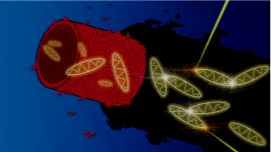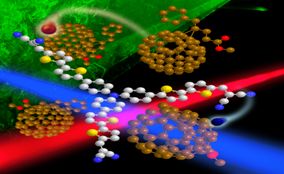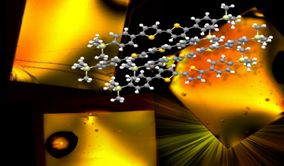Research projects
In the OCMP group, we use optical spectroscopy to study a wide range of ultrafast phenomena in organic materials at nanoscopic lengths and femtosecond (0.000000000000001 s) time scale, with the main focus on exciton and charge dynamics in energy-related and bio-inspired materials, and molecular motors. To unveil the underlying molecular-level dynamics, we harness the fundamental interactions between light and matter through ultrafast spectroscopy. Our arsenal comprises a comprehensive array of both techniques such as time-resolved photoluminescence and transient absorption. Of particular interest to us is the innovative two-dimensional correlation spectroscopy (2D CS), a potent tool that extracts maximal insights into systems under consideration.
The key research goals in recent years have been the understanding of exciton and charge dynamics in energy-related materials such as molecular aggregates, crystals and monolayers, ultrafast dynamics of IR driven fluorescent molecular motors, and self-assembly of artificial light-harvesting complexes.
Exciton dynamics in artificial light-harvesting complexes
 |
We have obtained (Nat. Comm. 2019; Phys.Chem.Chem.Phys. 2020; JACS 2020; Sci.Rep. 2022) a unifying picture of the exciton dynamics in artificial light-harvesting complexes, the so-called double-wall molecular nanotubes (DWNT). DWNTs appear to be remarkably robust against structural perturbations and able to adapt to different illumination conditions. We also made a first step towards understanding how supermolecular structure of DWNTs are self-assembled in aqueous environment (Sci. Rep. 2022, JACS 2023). We demonstrated that the self-assembly occurs in two stages: first, surface-adhered relatively small molecular structures are formed which are ordered internally but are disordered with respect to each other; and later, these structures rearrange to form the final well-ordered supramolecular double walled structure. This research is supported by NWO Open Competition Domain Science – KLEIN-2 (2020 – 2025) (together with Prof. Th.L.C.Jansen) |
Infrared-activated and photoluminescent molecular motors
 |
The great challenge for new generation of molecular motors is infrared light activation and making them fluorescent. With chemists from Prof. Feringa’s group, we have solved these issues (Science Advances 2020; Nat Comm 2022; Science Advances 2022). This opened up new possibilities for applications of molecular motors in biological settings and materials science with no harmful UV-blue light and possibility of tracking the motor’s location. |
Spectroscopy of new materials for organic solar cells
 |
Organic photovoltaics (OPV) stands as a dynamic domain within the realm of organic electronics, demonstrating remarkable promise for diverse applications, such as wearable technology and seamless integration into various devices. These solar cells utilize organic semiconductors to harness the energy of sunlight and convert it into electricity. The photon-to-energy conversion process in organic solar cells is a multifaceted journey, marked by several pivotal stages, including exciton photogeneration, exciton diffusion, exciton dissociation, and of geminate charge recombination. These intricate processes occur at remarkably rapid timescales, spanning from femtoseconds to nanoseconds, and hold a direct sway over the overall efficiency and efficacy of these groundbreaking devices. Our goal is to tackle these processes by employing time-resolved ultrafast spectroscopy as a powerful tool. Some of our publications on the topic: Advanced Functional Materials 26, 2016; Adv. Opt. Materials 5, 2017, Organic electronics 53 2018; ACS Appl. Mater. Interface 11 2019; Science advances 5 2019; Chem. Eur. J. 26, 2020; Scientific Reports 10 2020; Phys. Chem. Chem. Phys. 23, 2021; Materials Today Energy 22, 2021; Phys. Chem. Chem. Phys. 24, 2022. This research is supported by “Spins for Efficient Photovoltaic Devices based on Organic Molecules” (SEPOMO) - Innovative Training Network (2016-2021) and “Efficient Fullerene-Free organic solar cells” (EIFFEL) Doctoral Networks (DN) HORIZON-MSCA-2022-DN-01-01 (2023-2027). |
Exciton diffusion in molecular crystals and monolayers
 |
With our colleagues from Moscow State University (Prof. D.Yu. Paraschuk) and Russian Academy of Sciences (Prof. S.A. Ponomarenko), we introduced the concept of molecular self-doping in organic single crystals and monolayers (ACS Appl. Mater. Interfaces 9, 2017; Adv. Func. Materials 2018; J. Mater. Chem. C 2019, Mat. Chem. Frontiers 2023). This facilitated the enhancement of photoluminescence in the crystals and monolayers through the process of exciton diffusion to dopants. This research was supported by numerous Erasmus+ programme but had to be put on hold after February 24 2022. |
